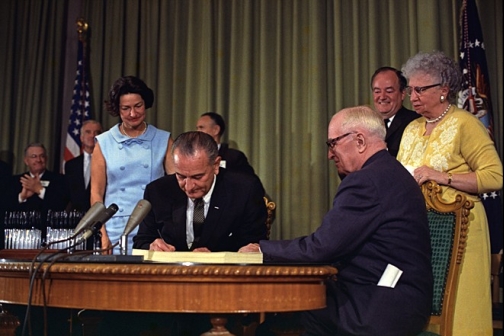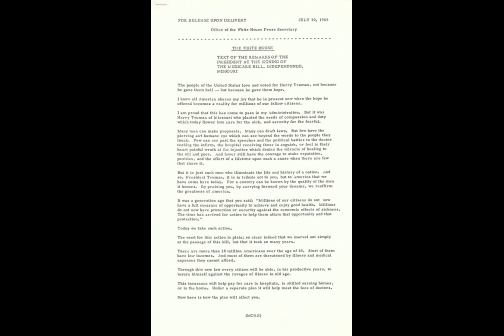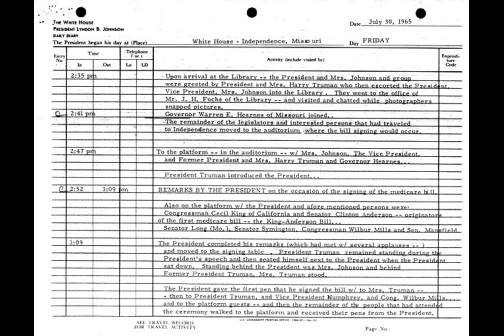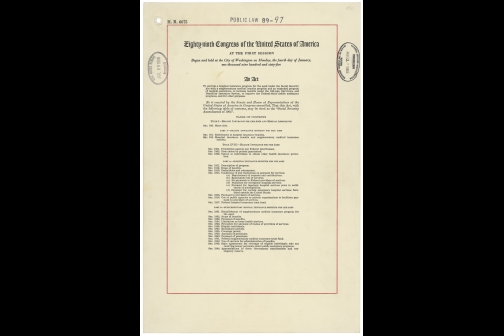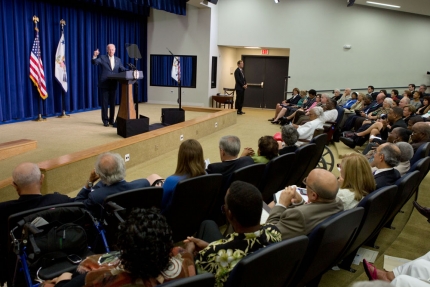Protecting the Middle Class News
The Fifth Anniversary of the American Recovery and Reinvestment Act
Posted by on February 17, 2014 at 2:00 PM EDTFive years ago, on February 17, 2009, less than a month into his first term, President Obama signed into law the American Recovery and Reinvestment Act of 2009. At the time, the country was experiencing the worst economic crisis since the Great Depression. Private employers had already cut almost 4 million jobs, trillions in dollars in household wealth had been wiped out, and the economy’s total output was in the midst of its sharpest downturn of the postwar era.
As part of the accountability and transparency provisions included in the Recovery Act, the Council of Economic Advisers was charged with providing to Congress quarterly reports on the Act’s effects. The final report in this series—and available HERE—affirms that the Recovery Act had a substantial positive impact on the economy, helped to avert a second Great Depression, and made targeted investments that will pay dividends long after the Act has fully phased out.
In the four years following the Recovery Act, the President built on this initial step, signing into law over a dozen fiscal measures that extended key features of the Act and provided new sources of support. These measures included a temporary payroll tax cut for 160 million working Americans, additional extensions to the Emergency Unemployment Compensation program, expanded business tax incentives, small business tax cuts, and funding to protect teacher jobs.
Learn more about , EconomyYou're Going to Want to Watch This Speech
Posted by on July 21, 2013 at 8:00 PM EDTI just finished reading the draft of a speech the President plans to deliver on Wednesday, and I want to explain why it’s one worth checking out.
Eight years ago, not long after he was elected to the United States Senate, President Obama went to Knox College in his home state of Illinois where he laid out his economic vision for the country. It’s a vision that says America is strongest when everybody’s got a shot at opportunity – not when our economy is winner-take-all, but when we’re all in this together.
Revisiting that speech, it’s clear that it sowed the seeds of a consistent vision for the middle class he’s followed ever since. It’s a vision he carried through his first campaign in 2008, it’s a vision he carried through speeches like the one he gave at Georgetown University shortly after taking office that imagined a new foundation for our economy and one in Osawatomie, Kansas on economic inequality in 2011 -- and it’s a vision he carried through his last campaign in 2012.
Watch that history here and see why this moment is so important.
All of these speeches – Knox College, Georgetown, Osawatomie – make clear that since day one, the President has had one clear economic philosophy: The American economy works best when it grows from the middle-out, not the top down.
Learn more about , Economy,The Employment Situation in June
Posted by on July 5, 2013 at 9:30 AM EDTWhile more work remains to be done, today’s employment report provides further confirmation that the U.S. economy is continuing to recover from the worst downturn since the Great Depression. It is critical that we remain focused on pursuing policies to speed job creation and expand the middle class, as we continue to dig our way out of the deep hole that was caused by the severe recession that began in December 2007.
Today’s report from the Bureau of Labor Statistics (BLS) indicates that private sector businesses added 202,000 jobs last month (see first chart below). Total non-farm payroll employment rose by 195,000 jobs in June. The economy has now added private sector jobs for 40 consecutive months, and a total of 7.2 million jobs has been added over that period. In spite of monthly volatility, over the past three years the pace of job growth has increased each year (see second chart below). So far this year, 1.23 million private sector jobs have been added.
The household survey showed that the unemployment rate remained at 7.6 percent in June down from 8.2 percent a year ago. The labor force participation rate rose by 0.1 percentage point for the second month in a row to 63.5 percent in June.
In the four years since the recession ended in June 2009, the economy has added 5.3 million jobs, thanks to the resilience of the American people and policies like the Recovery Act, which helped bring the recession to an end and put us on the path to recovery. With the recovery gaining traction, now is not the time for Washington to impose self-inflicted wounds on the economy. The President will continue to press Congress to act on the proposals he called for in his State of the Union address to make America a magnet for good jobs, help workers obtain the skills they need for those jobs, and make sure that honest work leads to a decent living.
Learn more about , EconomyPresident Obama Meets with AAPI National Leaders
Posted by on May 9, 2013 at 12:57 PM EDTYesterday, President Obama met with a group of Asian American and Pacific Islander (AAPI) national leaders to discuss his call for commonsense immigration reform that will strengthen the economy and grow the middle class. Here’s a part of the readout from the meeting:
The President emphasized that commonsense immigration reform continues to be a top legislative priority and that he looks forward to working with the AAPI community to achieve that goal. The leaders expressed their support for the principles that the President and key Senators working on immigration reform have laid out and their strong desire for a bill that provides a pathway to earned citizenship and supports family unity. The leaders also expressed their commitment to working with Congress to strengthen the legislation that is being considered. The President and the leaders also discussed a number of issues of importance to Asian Americans, Native Hawaiians, and Pacific Islanders, including efforts to provide affordable, accessible health care to AAPI communities. Finally, the President thanked participants for their leadership and commitment to ensuring that the American Dream remains attainable for all communities and families, as well as generations to come.
Gautam Raghavan is an Associate Director in the White House Office of Public Engagement
Learn more about , , ImmigrationWeekly Address: Congress Must Extend the Middle Class Tax Cuts
Posted by on December 8, 2012 at 6:30 AM EDTPresident Obama urges Congress to extend the middle class income tax cuts for 98 percent of Americans and 97 percent of small businesses without delay, making it clear that a balanced approach to deficit reduction means that Republicans in Congress must agree to ask the wealthiest Americans to pay higher tax rates.
Transcript | Download mp4 | Download mp3
Learn more
Hispanic-American Families Just Can’t Afford Tax Increases
Posted by on December 6, 2012 at 5:11 PM EDTAs the debate over the so-called "fiscal cliff" in Washington continues, much of the conversation centers on deficit reduction, revenues, and tax rates. But what is easily lost in that conversation is the very real meaning this has for families all across America. The fact is Hispanic-American families just can't afford tax increases right now, but that's what will happen if Congress fails to act. In fact the median Hispanic family of four would see their income taxes rise by $2,200. An astounding 99 percent of Hispanic families will be affected.
President Obama is committed to growing our economy from the middle out by ensuring a strong, secure, and thriving middle-class, and is proposing a balanced approach. There is no reason to hold middle-class families hostage while we debate tax cuts for millionaires and billionaires. Below you'll find a link to a fact sheet that shows how Hispanic families will be affected. We're also asking all of you to tell us what $2,000 means to your family's budget. Take a look at our #My2K page, and tell us on twitter what that money means to you.
And download the fact sheet on the Fiscal Cliff and Hispanic-American families here.
Learn more about , EconomyWeekly Address: Urging Congress to Extend the Middle Class Tax Cuts
Posted by on December 1, 2012 at 6:45 AM EDTPresident Obama speaks to the American people from a busy factory floor in Pennsylvania about the urgent need to pass the middle class tax cuts, which will give families and businesses preparing for the holidays the certainty they need going into the New Year. Democrats and Republicans must come together to pass one thing that everyone agrees on—extending income tax cuts for 98 percent of American families and 97 percent of small businesses, and there is no reason to wait. The President urges Congress to take action to help grow our economy and strengthen the middle class.
Transcript | Download mp4 | Download mp3
Learn more about President Obama's plan to extend the middle class tax cuts
Weekly Address: Working Together to Extend the Middle Class Tax Cuts
Posted by on November 17, 2012 at 6:45 AM EDTIn this week’s address, President Obama urges Congress to act now on one thing that everyone agrees on -- ensuring that taxes don’t go up on 98 percent of all Americans and 97 percent of small businesses at the end of the year. On Friday, the President had a constructive meeting with Congressional leaders on finding ways to reduce our deficit in a way that strengthens our economy and protects our middle class, and he looks forward to working together to get this done.
Transcript | Download mp4 | Download mp3
Learn more about President Obama's plan to extend the middle class tax cuts
Learn more about , EconomyWeekly Address: Extending Middle Class Tax Cuts to Grow the Economy
Posted by on November 10, 2012 at 6:45 AM EDTPresident Obama says that it’s time for Congress to pass the middle class tax cuts for 98 percent of all Americans. Both parties agree that this will give 98 percent of families and 97 percent of small businesses the certainty that will lead to growth, and so there is no reason to wait. On Tuesday, the American people voted for compromise and action, and the President calls on Congress to come together in that spirit to help create jobs and strengthen our economy.
Transcript | Download mp4 | Download mp3
Learn more about , EconomyAnnual Census Data on Income, Poverty, and Health Insurance for 2011
Posted by on September 12, 2012 at 12:34 PM EDTToday’s report shows that while we have made progress digging our way out of the worst economic crisis since the Great Depression, too many families are still struggling and Congress must act on the policies President Obama has put forward to strengthen the middle class and those trying to get into it.
Real median income declined by $777 to $50,054 in 2011. This decline in income is another example of why it was so important for Congress to pass the President’s payroll tax cut - which put $1,000 in the pocket of approximately 160 million working Americans last year, thus providing an important cushion for families that saw their pre-tax incomes decrease in 2011. More recent data available for 2012, including data on job growth, unemployment and wages, indicate that real median income is growing this year. In addition, data from the government’s Current Population Survey analyzed by Sentier Research indicate that median household income has grown $1,176 in the last 12 months; although these data are not as reliable as the comprehensive Census estimates, they are an indicator of more recent trends in income.
Still, too many Americans are feeling the effects of the crisis, which is why the President believes Congress must vote this month to extend the middle class tax cuts to ensure that 98 percent of Americans do not see a significant tax hike at the end of the year. If Congress fails to act, the typical middle class family will face a $2,200 tax increase. Middle class families need economic certainty and Republicans in Congress should not hold these middle class tax cuts hostage simply to preserve massive tax breaks for millionaires and billionaires. Moreover, if Congress is truly concerned about income levels, it should act this month to pass job creation proposals in the President’s American Jobs Act – which independent economists believe would create 1 million jobs and has been before Congress for over a year.
Today’s report also shows that thanks in part to the Affordable Care Act, 1.3 million fewer people were uninsured in 2011. Today’s report also shows that thanks in part to the Affordable Care Act, 3.6 million more people were covered by health insurance in 2011 and the percentage of the population without insurance declined from 16.3 percent in 2010 to 15.7 percent in 2011. In addition, the rate of private insurance coverage was essentially unchanged in 2011 for the first time in a decade.
Learn more about , EconomyThe Health Care Law is Saving Americans Money
Posted by on September 11, 2012 at 12:18 PM EDTEd. note: This is cross-posted from Healthcare.gov.
The Affordable Care Act holds insurance companies accountable and puts more money back into the pockets of Americans across the country. According to a new report, consumers saved over $2 billion because of new rules that protect people from insurance industry abuses.
As a former Insurance Commissioner, I’m familiar with how alone consumers can feel when dealing with their insurance companies. Under the health care law, insurers are finally being held accountable to their policyholders. For the first time ever, new rate review rules in the health care law prevent insurance companies in all states from raising rates with no accountability or transparency. Forty-five states and the District of Columbia have received $160 million in grants to increase their oversight of premium hikes.
Some states, like Nevada, are using the funds to better educate consumers about the resources available to them. Others – like Mississippi and South Dakota – have used the money to add new consumer protections. In these states, officials can not only review rate hikes, but can also reject those hikes that are not justified.
Learn more about Health CarePresident Obama Continues the Push for Middle Class Tax Cuts
Posted by on August 3, 2012 at 3:38 PM EDT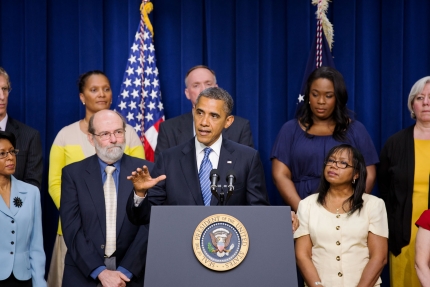
President Barack Obama delivers remarks on extending tax cuts for the middle class, in the Eisenhower Executive Office Building, South Court Auditorium, Aug. 3, 2012. (Official White House Photo by Sonya N. Hebert)
Unless the the House of Representatives takes action before January 1, a typical middle-class family of four will see their taxes go up by $2,200 in the coming year.
President Obama is fighting to prevent that from happening, and today, he again pushed lawmakers to get this done.
"What we should do right now is give middle-class families and small business owners a guarantee that their taxes will not go up next year," he said. "When families have the security of knowing that their taxes won’t go up they’re more likely to spend, and more likely to grow the economy. When small business owners have certainty on taxes and can plan ahead they’re more likely to hire and create new jobs. And that benefits all of us."
Getting Women the Care They Need
Posted by on August 1, 2012 at 2:04 PM EDTAs chair of the White House Council on Women and Girls, I am incredibly proud to highlight an important part of the health care law that gives women more control over their health care. Thanks to the Affordable Care Act, 47 million women will have access to the preventive services they need. We all know that women and men face unique health risks and benefit from different preventive services. For too long, too many women have gone without these services due to out-of-pocket costs or lack of coverage.
Under the Affordable Care Act, for the first time ever, women will now have access to life-saving preventive care, such as mammograms and contraception, without paying any more out of their own pockets.
Learn more about Health Care, WomenFrom the Archives: The Medicare Bill of 1965
Posted by on July 30, 2012 at 12:28 PM EDTOn July 30, 1965, President Lyndon B. Johnson signed into law the Social Security Act Amendments, popularly known as the Medicare bill. It established Medicare, a health insurance program for the elderly, and Medicaid, a health insurance program for the poor.
Former President Truman participated in the signing ceremony with President Johnson. Harry S. Truman and Bess Truman received Medicare registration cards numbers one and two. At the time, Mr. Truman was 81 years old, and he described it as a “profound personal experience for me.”
The National Archives have put together a gallery featuring images and artifacts from the event in Independence, Missouri 47 years ago today. Check it out:
Learn more about the Medicare bill: http://www.ourdocuments.gov/doc.php?flash=true&doc=99
Learn more about Health Care, Additional IssuesNew “Shopping Sheet” Will Make It Easier for Students to “Know Before They Owe”
Posted by on July 24, 2012 at 1:55 PM EDTEditor’s Note: You can read more about the Shopping Sheet in a post on the official blog of U.S. Department of Education.
Almost every day, President Obama gets letters from students who are swimming in student loan debt, and every week it seems we see another newspaper article about how the cost of college is becoming prohibitively expensive for too many American families.
We know that college remains an excellent investment. Increasingly however, it is a financed investment, with the monthly loan payments to prove it. And, while we don’t want would-be students to be scared away from going to college because of the price, we aren’t doing students any favors by obscuring the reality of this commitment until after they’ve graduated.
While this Administration continues to do everything we can to make sure that college remains affordable and available to families in the middle class and those aspiring to the middle class, we also are focused on making it easier for families to understand the costs and benefits of higher education up-front, so that they can more easily choose a college that is both high-quality and affordable.
An American Renaissance in Manufacturing Happening In Kansas City and Columbia, Missouri
Posted by on July 23, 2012 at 6:53 PM EDTEd note: this post was originally published on The Commerce Blog, the official blog of the U.S. Department of Commerce
I am back in my home state of Missouri today, so it is even more of a treat to witness firsthand the resurgence in American manufacturing. I visited two manufacturers today – the A. ZAHNER Company, in Kansas City, and Environmental Dynamics International (EDI), in Columbia – and had the chance to talk to some remarkable local businesses leaders and entrepreneurs in both cities.
Under President Obama’s leadership, and with the hard work of businesses and workers like those here in Missouri, our private sector has now seen 28 straight months of job growth – 4.4 million jobs. Of course, there is more work to be done, but we are making progress in critical areas. Over the last two and a half years, we’ve seen the strongest growth in manufacturing jobs since the 1990s. Missouri alone has gained nearly 9,000 new manufacturing jobs since 2010.
On top of that, manufacturers in states like Missouri are realizing that investing here at home is both the right thing to do and the smart thing to do. Many businesses – both here and abroad – are deciding to keep jobs here, bring jobs back to the U.S., or to set up operations here for the first time—a trend called “insourcing.”
We need to do everything possible to support businesses in places like Missouri that are thinking about insourcing. The Obama Administration will continue to call on Congress to pass legislation to give our companies a tax break if they move operations and jobs back.
Learn more about Economy,Wall Street Reform Two-Years Later: Reforming the System and Protecting American Consumers
Posted by on July 21, 2012 at 3:06 PM EDTIt’s now been almost four years since irresponsibility in certain corners of Wall Street nearly caused our entire economy to collapse. Today, it’s pretty clear to most of us that the rules we once had in place to protect our financial system were old and poorly enforced. They allowed dangerous risk-taking to go unchecked. And when the largest financial institutions did fail, they left hardworking taxpayers holding the bag. And as we dug our way out of the worst recession of our lives, President Obama promised to reform the system so this never happened again.
That’s why, two years ago today, President Obama signed into law Wall Street reform that put in place smarter, tougher, commonsense rules of the road and the strongest consumer protections in history. For example, if you’re a big bank or financial institution, you now have to hold more cash on hand so that if you make a bad decision, you pay for it, not the taxpayers. You’re no longer going to be able to make risky bets with your customers’ deposits. And the new law creates new authorities to claw back outsized compensation from failed CEOs, while finally giving shareholders a say on executive salaries.
We continue to make steady progress on these fronts. Just this month, nine of the largest banks submitted “living wills” that details how they’ll pay for things if they end up failing. These wills will complement the new authorities we’ve put in place that allow regulators to break up and wind down large firms so taxpayers are never again left on the hook for banks’ failures. In June, regulators approved final rules that will force banks to hold more cash on hand for their trading activities and any potential losses.
But Wall Street reform isn’t just about reigning in Wall Street excess. It’s also about protecting Main Street families. For the first time in our history, we now have an independent consumer watchdog with one job: to look out for you. That means making sure you’ve got all the information you need to make important financial decisions. And it means going after anyone – from mortgage brokers to payday lenders to debt collectors – who deals with you dishonestly.
Just this week, that consumer watchdog put in place rules to supervise credit bureaus. This marks the first time in history that these companies will be subject to federal supervision. And working together with other regulators, they ordered Capital One Bank to refund $150 million dollars directly to 2 million customers who were deceived or misled into buying things they didn’t understand or didn’t even want.
The consumer watchdog has also set up a toll free number you can call to make sure you’re getting a fair deal on your mortgage – and to hold banks accountable if you’re not. You can reach them at (855) 411-2372.They recently put together a new mortgage disclosure form that spells out – in simple terms – how much you’re going to owe on your home. No more hiding things in fine print.
And they’ve set up a new website that makes it easier than ever for you to report on a whole range of financial abuse. If you’re applying for a credit card, opening a bank account, or trying to get a student loan and something doesn’t seem right, go to www.consumerfinance.gov/complaints and let them know. Not only will they bring your complaint directly to the company in question, they’ll give you a tracking number so that you can check back and see exactly what’s being done on your behalf.
That’s what Wall Street reform is all about – looking out for hardworking Americans by making sure everyone plays by the same rules. We’ve come too far to go back to an era of top-down, on-your-own economics. Now is the time to move forward; to strengthen the middle class; and to rebuild an economy where everyone can have the confidence that if they work hard, they can get ahead.Learn more about the Dodd-Frank Wall Street Reform and Consumer Protection Act.
Learn more aboutReforming Wall Street, Protecting Main Street: An Update on Wall Street Reform
Posted by on July 19, 2012 at 3:40 PM EDTEd. note: This is cross-posted from Treasury Notes
Two years ago this week, President Obama signed the Dodd-Frank Wall Street Reform and Consumer Protection Act -- the most significant set of financial reforms since the Great Depression. The landmark law is designed to help protect Americans from the excessive risk, fragmented oversight, and poor consumer protections that played leading roles in bringing about the recent financial crisis.
Treasury and the independent regulators have made meaningful progress implementing the law, which is vital to restoring trust in the underlying safety, stability, and integrity of the financial system, and to rebuilding a pro-growth, pro-investment environment. To outline the progress made, the U.S. Department of the Treasury has developed an overview of where reform stands and the changes it has effected on the financial system to date. For a copy of the overview, please click here.
Learn more aboutSo How Many Consumer Reporting Companies Are There?
Posted by on July 17, 2012 at 4:57 PM EDTEd note: The Consumer Financial Protection Bureau (CFPB) announced yesterday that they adopted a rule to begin supervising larger consumer reporting agencies, which include what are popularly called credit bureaus or credit reporting companies. This is the first time these companies will be supervised at the federal level. This blog post, originally published on the CFPB blog, explains what this will mean for consumers.
You may know about the three biggest nationwide credit reporting companies: Experian, Equifax, and TransUnion. But did you know that there are other companies out there that may be providing reports on you that could be used to decide if you’re eligible for consumer financial, insurance, medical and other products?
Today the CFPB is posting a list of consumer reporting companies – companies that collect information and write reports that could be used to decide if you will be able to get credit, insurance, or a job. This list doesn’t cover every company in the industry. It’s a list of companies that have identified themselves as consumer reporting companies or provide consumers access to their consumer reports. (1) The list includes both the biggest nationwide credit reporting companies and a longer list of “specialty reporting companies.”
Specialty reporting companies focus on certain industries. Just like the three biggest nationwide credit reporting companies, specialty reporting companies collect and share information with creditors and other businesses. There are a lot of these companies on the list, so we’re also trying to give tips on which of them may be important to you. The list also has information about how you can get copies of your reports (see below).
Learn more about Economy,Vice President Biden Speaks To Seniors About Retirement Security
Posted by on July 16, 2012 at 6:52 PM EDTToday, the Vice President spoke to more than 100 community leaders from across the country representing over 60 seniors groups that are part of the Leadership Council of Aging Organizations. He told the audience that when it comes to Social Security and Medicare, “the question is what are we going to do to strengthen and sustain these programs now and for the future.” In contrast, Congressional Republicans are trying to weaken or dismantle these programs.
Last year, Congressman Paul Ryan proposed to end traditional Medicare. His plan, which was embraced by his Republican colleagues, would give seniors a voucher to buy private insurance and hold them responsible for any costs that exceed the value of the voucher. As a result, the typical 65-year-old’s out-of-pocket health care costs would double over time. While Congressman Ryan introduced a revised plan this year, it still relies on a voucher system that would increase the financial burden on seniors.
President Obama and Vice President Biden want to strengthen Medicare and secure the program for the future. Our health care law extends the life of Medicare by eight years by taking smart steps like cutting waste and fraud and creating incentives to cut down on hospital readmissions. These steps will save seniors in traditional Medicare an average of $160 on premiums and copays in 2012 alone. In addition, the law has already saved 5.3 million seniors an average of $600 on prescription drugs by closing the “donut hole,” and has ensured that over 30 million have access to free preventive services like cancer screenings and annual wellness visits.











